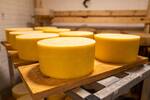
05 Aug Study Finds Promising Effects of Jarlsberg® Cheese on Bone and Metabolic Markers
MedicalResearch.com Interview with:
Stig Larsen
PhD
Professor Emeritus
Controlled Clinical Research Methodology and Statistics
Norwegian University of Life Sciences
Oslo, Norway
MedicalResearch.com:? What are the main findings?
Response: Osteoporosis is a major problem among elderly and malnourished people. Calcium, Vitamin D and Vitamin K are beneficial for bone health. Vitamin D stimulates calcium absorption and studies have shown that poor Vitamin K status intake is linked to low bone mass. Osteocalcin (OC) is a protein hormone found in the blood in activated and inactivated form. The activated form of Osteocalcin (cOC) binds calcium to bone tissue and plays an important role in regulating the metabolism. In addition, low levels of cOC are associated with insulin resistance, diabetes, and metabolic syndrome. It is desirable to have largest possible uOC, and vitamin K2 central in this process.
The most important vitamin K2 variants in Jarlsberg® are the long-chain MK-7, -8, -9 and -9(4H), where lactic acid bacteria produce the first three, while MK-9(4H) is produced by Propionibacterium freudenreichii. The latter bacterium also produces the substance “1,4-dihydroxy-2- naphthoic acid” (DHNA), which has previously been shown to increase bone density in experimental mice. Two previous studies related to Jarlsberg® intake have been published:
- The first study showed that cOC in the blood increased with increasing Jarlsberg® dose up to a daily intake of 57 grams of Jarlsberg®. Even more startling was that the total OC (tOC) level increased significantly, and that triglycerides and cholesterol were significantly reduced.1
- The second study reproduced the findings from the first study and demonstrated additionally that the Jarlsberg dose of 57g/day could be reduced to 45 grams after 6 weeks without reducing the achieved level of tOC and vitamin K2.2
The BMJ-study3: The central variables measured in this study were the serum bone turnover markers (BTM); tOC and cOC, procollagen type 1 N-terminal propeptide (PINP) and serum cross-linked C- telopeptide type I collagen (CTX). Additionally, Vitamin K2 and Vitamin K status, serum calcium and serum magnesium were recorded together with the development in glycated hemoglobin (HbA1c), lipids and protein turnover.
The participants in the study were randomly divided into two groups. One group of 41 healthy volunteer women of childbearing age ate 57 grams of Jarlsberg® per day and the other group of 25 women ate 50 grams of Camembert for 6 weeks. The Camembert was manufactured with a starting culture not producing Vitamin K2. The fat, protein, and energy content of the daily consumption of Jarlsberg® and Camembert is approximately the same. After 6 weeks, Camembert was replaced with 57 grams of Jarlsberg® per day for another 6 weeks.
MedicalResearch.com: What are the main findings?
Response: The BTM osteogenesis markers tOC, cOC and PINP, demonstrated significant increase, while the bone resorption marker CTX showed no change over the course of 6 weeks in the group that received Jarlsberg®. Additionally, Vitamin K2 and Vitamin K status in the blood increased significantly and HbA1c, serum calcium and serum magnesium decreased significantly during the 6 weeks of daily Jarlsberg® intake. In the group that received Camembert, all the bone markers, Vitamin K2, and Vitamin K status, HbA1C, calcium and magnesium remained largely unchanged. After the switch from Camembert to Jarlsberg®, all BTMs demonstrated significantly increased bone density after additionally 6 weeks. Vitamin K2 and Vitamin K status increased significantly and HbA1C, serum calcium and magnesium decreased as detected in the group initially allocated to Jarlsberg®.
MedicalResearch.com: What should readers take away from your report?
MedicalResearch.com: Jarlsberg® show promising results on developing bone-specific markers. These effects can likely be caused by the contents of long chained side Vitamin K2 and DHNA. Daily intake of 57-gram Jarlsberg® indicates prophylactic effect on osteopenia and metabolic disease such as diabetes-2.
MedicalResearch.com: What recommendations do you have for future research as a result of this study?
Response: The present results must be further investigated in a long- term study on a larger sample of elderly females and males in risk of developing osteoporosis. In the present studies no bone mineral density (BMD) is measured. In a future study the biochemical results on BTM must be held up against the changes in BMD. Additionally, the effect on HbA1c and lipids have to be further investigated.
References:
- Lundberg HE, Holand T, Holo H & Larsen S. Increased serum osteocalcin levels and vitamin K status by daily cheese intake. Int J Clin Trials. 2020 May;7(2):55-65. http://www.ijclinicaltrials.com
- Lundberg HE, Holo H, Holand T, Fagertun HE & Larsen S Determination of maintenance Jarlsberg® cheese dose to keep the obtained serum osteocalcin level; a response surface pathway designed de-escalation dose study with individual starting values. Int J Clin Trials. 2021 August;8(3):174-83
- Lundberg HE, Glasø M, Chhura R, Shukla AA, Austlid TL, Sarwar Z, Hovland K, Iqbal S, Fagertun HE, Holo H & Larsen S. Effect on bone anabolic markers of daily cheese intake with and without vitamin K2: a randomised clinical trial. BMJ Nutrition, Prevention & Health. 2022 August.
Citation:
Effect on bone anabolic markers of daily cheese intake with and without vitamin K2: a randomised clinical trial
BMJ Nutrition Prevention & Health
10.1135/bmjnph-2022-000424
Editors note: This is an early study. Do not make dietary changes without consulting your health care provider.
The information on MedicalResearch.com is provided for educational purposes only, and is in no way intended to diagnose, cure, or treat any medical or other condition. Always seek the advice of your physician or other qualified health and ask your doctor any questions you may have regarding a medical condition. In addition to all other limitations and disclaimers in this agreement, service provider and its third party providers disclaim any liability or loss in connection with the content provided on this website.
Last Updated on August 5, 2022 by Marie Benz MD FAAD
